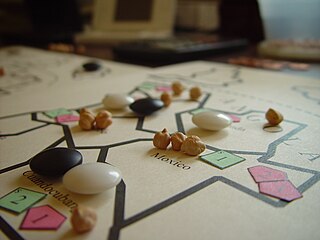A massively multiplayer online role-playing game (MMORPG) is a video game that combines aspects of a role-playing video game and a massively multiplayer online game.
A game programmer is a software engineer, programmer, or computer scientist who primarily develops codebases for video games or related software, such as game development tools. Game programming has many specialized disciplines, all of which fall under the umbrella term of "game programmer". A game programmer should not be confused with a game designer, who works on game design.

The Game Developers Conference (GDC) is an annual conference for video game developers. The event includes an expo, networking events, and awards shows like the Game Developers Choice Awards and Independent Games Festival, and a variety of tutorials, lectures, and roundtables by industry professionals on game-related topics covering programming, design, audio, production, business and management, and visual arts.
Video game design is the process of designing the rules and content of video games in the pre-production stage and designing the gameplay, environment, storyline and characters in the production stage. Some common video game design subdisciplines are world design, level design, system design, content design, and user interface design. Within the video game industry, video game design is usually just referred to as "game design", which is a more general term elsewhere.
Video game development is the process of creating a video game. It is a multidisciplinary practice, involving programming, design, art, audio, user interface, and writing. Each of those may be made up of more specialized skills; art includes 3D modeling of objects, character modeling, animation, visual effects, and so on. Development is supported by project management, production, and quality assurance. Teams can be many hundreds of people, a small group, or even a single person.
Game programming, a subset of game development, is the software development of video games. Game programming requires substantial skill in software engineering and computer programming in a given language, as well as specialization in one or more of the following areas: simulation, computer graphics, artificial intelligence, physics, audio programming, and input. For multiplayer games, knowledge of network programming is required. In some genres, e.g. fighting games, advanced network programming is often demanded, as the netcode and its properties are considered by players and critics to be some of the most important metrics of the game's quality. For massively multiplayer online games (MMOGs), even further knowledge of database programming and advanced networking programming are required. Though often engaged in by professional game programmers, there is a thriving scene of independent developers who lack a relationship with a publishing company.

Katamari Damacy is a third-person puzzle-action video game developed and published by Namco for the PlayStation 2. It was released in Japan in March 2004 and later in North America in September. Designer Keita Takahashi struggled to pitch the game to Namco's superiors, eventually seeking student aid from the Namco Digital Hollywood Game Laboratory to develop the project for less than US$ 1 million. As director, Takahashi emphasized concepts of novelty, ease of understanding, and enjoyment.
Game Developer is a website created in 1997 that focuses on aspects of video game development. It is owned and operated by Informa and acted as the online sister publication to the print magazine Game Developer prior to the latter's closure in 2013.
The Indie Game Jam (IGJ) was an effort to rapidly prototype video game designs and inject new ideas into the game industry. Started in 2002 by a group of game designer-programmers, the event featured a shared game engine technology and worked on by other designer-programmers for a single long weekend. The games resulting from that weekend were then published, open-source, on the IGJ web page.
Doom, a first-person shooter game by id Software, was released in December 1993 and is considered one of the most significant and influential video games in history. Development began in November 1992, with programmers John Carmack and John Romero, artists Adrian Carmack and Kevin Cloud, and designer Tom Hall. Late in development, Hall was replaced by Sandy Petersen and programmer Dave Taylor joined. The music and sound effects were created by Bobby Prince.
In video games, a level is any space available to the player during the course of completion of an objective. Video game levels generally have progressively increasing difficulty to appeal to players with different skill levels. Each level may present new concepts and challenges to keep a player's interest high.

A video game clone is either a video game or a video game console very similar to, or heavily inspired by, a previous popular game or console. Clones are typically made to take financial advantage of the popularity of the cloned game or system, but clones may also result from earnest attempts to create homages or expand on game mechanics from the original game. An additional motivation unique to the medium of games as software with limited compatibility, is the desire to port a simulacrum of a game to platforms that the original is unavailable for or unsatisfactorily implemented on.
Game testing, also called quality assurance (QA) testing within the video game industry, is a software testing process for quality control of video games. The primary function of game testing is the discovery and documentation of software defects. Interactive entertainment software testing is a highly technical field requiring computing expertise, analytic competence, critical evaluation skills, and endurance. In recent years the field of game testing has come under fire for being extremely strenuous and unrewarding, both financially and emotionally.

Brenda Louise Romero, previously known as Brenda Brathwaite, is an American game designer and developer in the video game industry. She was born in Ogdensburg, New York and is a graduate of Clarkson University. Romero is best known for her work on the Wizardry series of role-playing video games and, more recently, the non-digital series The Mechanic is the Message. She has worked in game development since 1981 and has credits on 49 game titles.

Descent to Undermountain is a role-playing video game developed and published by Interplay in 1998. Based on the Dungeons & Dragons setting of Undermountain in the Forgotten Realms, it casts the player as an adventurer out to explore the treasure-filled recesses of the Undermountain dungeon. The "Descent" part of the name refers to the game's use of the 3D rendering engine from the 1995 game Descent.

Health is a video game or tabletop game quality that determines the maximum amount of damage or fatigue something takes before leaving the main game. In role-playing games, this typically takes the form of hit points (HP), a numerical attribute representing the health of a character or object. The game character can be a player character, a boss, or a mob. Health can also be attributed to destructible elements of the game environment or inanimate objects such as vehicles and their individual parts. In video games, health is often represented by visual elements such as a numerical fraction, a health bar or a series of small icons, though it may also be represented acoustically, such as through a character's heartbeat.

An indie game, short for independent video game, is a video game created by individuals or smaller development teams without the financial and technical support of a large game publisher, in contrast to most "AAA" (triple-A) games. Because of their independence and freedom to develop, indie games often focus on innovation, experimental gameplay, and taking risks not usually afforded in AAA games. Indie games tend to be sold through digital distribution channels rather than at retail due to a lack of publisher support. The term is synonymous with that of independent music or independent film in those respective mediums.
Game art design is a subset of game development involving the process of creating the artistic aspects of video games. Video game art design begins in the pre-production phase of creating a video game. Video game artists are visual artists involved from the conception of the game who make rough sketches of the characters, setting, objects, etc. These starting concept designs can also be created by the game designers before the game is moved into actualization. Sometimes, these concept designs are called "programmer art". After the rough sketches are completed and the game is ready to be moved forward, those artists or more artists are brought in to develop graphic designs based on the sketches.

Game design is the process of creating and shaping the mechanics, systems and rules of a game. Games can be created for entertainment, education, exercise or experimental purposes. Additionally, elements and principles of game design can be applied to other interactions, in the form of gamification. Game designer and developer Robert Zubek defines game design by breaking it down into its elements, which he says are the following:
Metroidvania is a sub-genre of action-adventure games and/or platformers focused on guided non-linearity and utility-gated exploration and progression. The term is a portmanteau of the names of the video game series Metroid and Castlevania, based on the template from Metroid (1986), Castlevania II (1987), Super Metroid (1994), and Castlevania: Symphony of the Night (1997).








